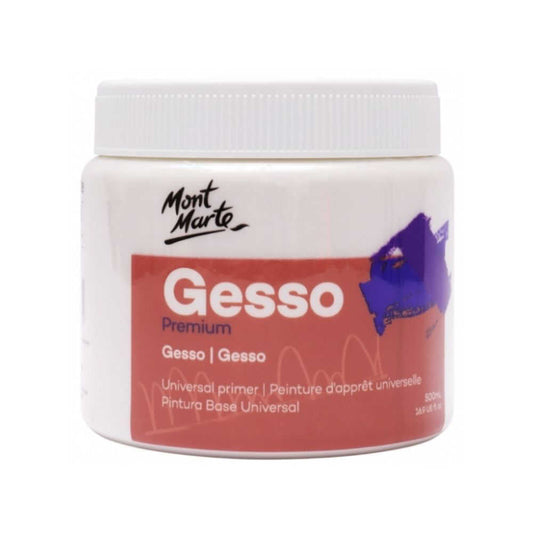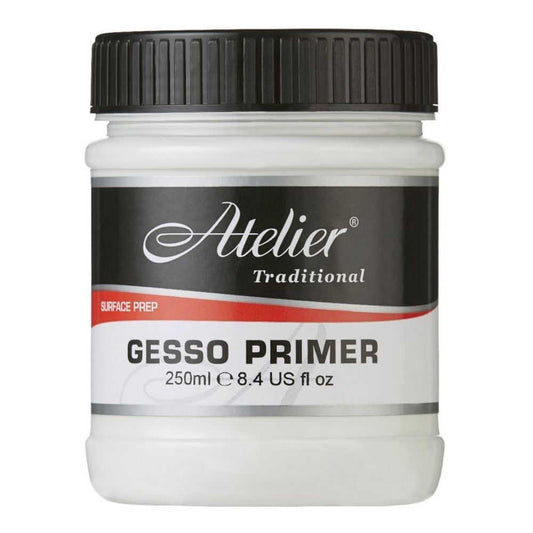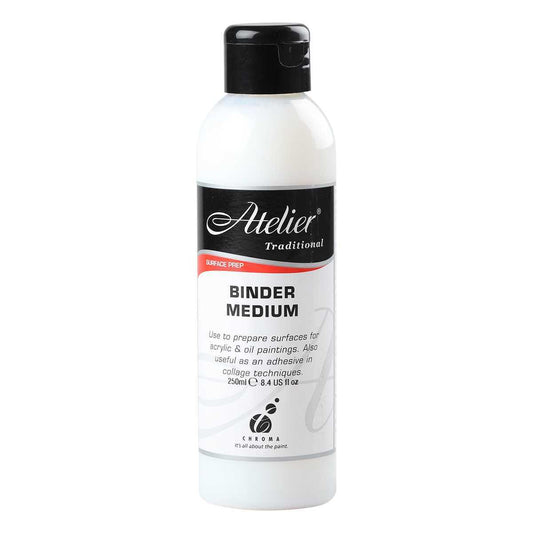Gesso & Primers
Prepare surfaces for painting with Art to Art’s range of gesso, primer, and grounds. Whether you’re doing acrylic, watercolour, or oil painting, you’ll find the perfect primer. Choose from trusted brands including Matisse, Mont Marte, Golden, and Art Spectrum. Shop artist gesso online today at affordable prices.
Use our high-quality gesso primers to prepare canvas, paper, card, wood, and more. The consistency varies by brand: fluid gesso spreads thinly over large areas; thick gesso builds texture. Some dry ultra-smooth, others create a toothy surface for paint grip. Experiment to find your ideal match.
-
Matisse Background Coloured Gesso
Regular price $19.95Regular priceUnit price / per -
-
Mont Marte White Gesso Primer
Regular price From $14.95Regular priceUnit price / per -
Michael Harding Non Absorbent Primer
Regular price From $44.95Regular priceUnit price / per -
Atelier Acrylic Gesso Primer
Regular price From $17.95Regular priceUnit price / per -
Daniel Smith Watercolour Ground
Regular price From $24.95Regular priceUnit price / per -
Matisse Watercolour Ground Absorbent Primer
Regular price From $21.95Regular priceUnit price / per -
Langridge Clear Primer
Regular price From $34.95Regular priceUnit price / per -
Atelier Binder Medium
Regular price From $18.95Regular priceUnit price / per -
-
Daniel Smith Watercolour Ground Transparent
Regular price $24.95Regular priceUnit price / per -
Matisse Transparent Gesso
Regular price From $21.95Regular priceUnit price / per -
-
Golden Acrylic Pastel Ground
Regular price From $34.95Regular priceUnit price / per -
Art Spectrum Colourfix Smooth Primer
Regular price From $24.95Regular priceUnit price / per -
Langridge Oil Primer
Regular price From $44.95Regular priceUnit price / per
{"type":"root","children":[{"type":"paragraph","children":[{"type":"text","value":"What is gesso?","bold":true},{"type":"text","value":"\nGesso is a foundational primer that seals raw surfaces and prevents paint absorption. Without it, paint soaks into canvas weave — causing dull, uneven results. Pre-stretched canvases come primed, but often "},{"type":"text","value":"under-primed","bold":true},{"type":"text","value":". Adding "},{"type":"text","value":"2–3 extra coats","bold":true},{"type":"text","value":" dramatically improves vibrancy, adhesion, and longevity."}]},{"type":"heading","level":3,"children":[{"type":"text","value":"How to Apply Gesso for a Smooth Finish"}]},{"type":"list","listType":"ordered","children":[{"type":"list-item","children":[{"type":"text","value":"Apply thin layers","bold":true},{"type":"text","value":" with a wide brush using even strokes."}]},{"type":"list-item","children":[{"type":"text","value":"Smooth edges","bold":true},{"type":"text","value":" with a clean, dry brush before drying."}]},{"type":"list-item","children":[{"type":"text","value":"Let dry fully","bold":true},{"type":"text","value":" (1–2 hrs per coat)."}]},{"type":"list-item","children":[{"type":"text","value":"Lightly sand","bold":true},{"type":"text","value":" with fine-grit sandpaper between coats."}]},{"type":"list-item","children":[{"type":"text","value":"Repeat until desired smoothness (usually "},{"type":"text","value":"2–3 coats","bold":true},{"type":"text","value":")."}]}]},{"type":"heading","level":3,"children":[{"type":"text","value":"Types of Gesso, Primer & Grounds"}]},{"type":"list","listType":"unordered","children":[{"type":"list-item","children":[{"type":"text","value":"White Gesso","bold":true},{"type":"text","value":" – Classic primer for all media"}]},{"type":"list-item","children":[{"type":"text","value":"Clear Gesso","bold":true},{"type":"text","value":" – Maintains surface texture/colour"}]},{"type":"list-item","children":[{"type":"text","value":"Black Gesso","bold":true},{"type":"text","value":" – Dramatic dark grounds"}]},{"type":"list-item","children":[{"type":"text","value":"Coloured Gesso","bold":true},{"type":"text","value":" – Tinted bases (mix with acrylic)"}]},{"type":"list-item","children":[{"type":"text","value":"Watercolour Ground","bold":true},{"type":"text","value":" – Enables watercolour on non-paper"}]},{"type":"list-item","children":[{"type":"text","value":"Absorbent/Non-Absorbent Grounds","bold":true},{"type":"text","value":" – For oil/acrylic flexibility"}]},{"type":"list-item","children":[{"type":"text","value":"Student vs Artist Grade","bold":true},{"type":"text","value":" – Artist grade = higher pigment, better opacity; Student = more fillers, budget-friendly"}]}]},{"type":"heading","level":3,"children":[{"type":"text","value":"Step-by-Step: Make Tinted Gesso"}]},{"type":"list","listType":"ordered","children":[{"type":"list-item","children":[{"type":"text","value":"Start with "},{"type":"text","value":"white or clear gesso","bold":true},{"type":"text","value":"."}]},{"type":"list-item","children":[{"type":"text","value":"Mix in "},{"type":"text","value":"acrylic paint","bold":true},{"type":"text","value":" (10–30% by volume)."}]},{"type":"list-item","children":[{"type":"text","value":"Stir thoroughly — avoid bubbles."}]},{"type":"list-item","children":[{"type":"text","value":"Apply as usual. Creates custom-coloured grounds."}]}]},{"type":"paragraph","children":[{"type":"text","value":"Can gesso be used on non-traditional surfaces?","bold":true},{"type":"text","value":"\nYes — prime "},{"type":"text","value":"vinyl records","bold":true},{"type":"text","value":", "},{"type":"text","value":"wood panels","bold":true},{"type":"text","value":", "},{"type":"text","value":"MDF","bold":true},{"type":"text","value":", "},{"type":"text","value":"cigar boxes","bold":true},{"type":"text","value":", "},{"type":"text","value":"metal","bold":true},{"type":"text","value":", "},{"type":"text","value":"glass","bold":true},{"type":"text","value":", or "},{"type":"text","value":"plaster","bold":true},{"type":"text","value":". Lightly sand non-absorbent surfaces first."}]},{"type":"heading","level":3,"children":[{"type":"text","value":"How to Use Gesso by Medium"}]},{"type":"paragraph","children":[{"type":"text","value":"For Acrylic:","bold":true},{"type":"text","value":"\nApply undiluted with brush/roller. "},{"type":"text","value":"2+ coats","bold":true},{"type":"text","value":" recommended. Thin with water on raw canvas. Moisten canvas slightly for smoother spread."}]},{"type":"paragraph","children":[{"type":"text","value":"For Oil:","bold":true},{"type":"text","value":"\nUse "},{"type":"text","value":"oil or acrylic-based gesso","bold":true},{"type":"text","value":" — "},{"type":"text","value":"3 coats","bold":true},{"type":"text","value":" ideal. Thin with water. Paint next day once moisture evaporates."}]},{"type":"paragraph","children":[{"type":"text","value":"For Watercolour:","bold":true},{"type":"text","value":"\nUse "},{"type":"text","value":"Watercolour Ground","bold":true},{"type":"text","value":" straight from jar. "},{"type":"text","value":"1–2 coats","bold":true},{"type":"text","value":". Cure "},{"type":"text","value":"24+ hours","bold":true},{"type":"text","value":" before painting."}]},{"type":"heading","level":3,"children":[{"type":"text","value":"Gesso, Primer & Grounds FAQs"}]},{"type":"paragraph","children":[{"type":"text","value":"What does gesso primer do?","bold":true},{"type":"text","value":"\n"},{"type":"text","value":"Gesso","bold":true},{"type":"text","value":" primes raw canvas, linen, or wood to prevent artist paint absorption. Creates a "},{"type":"text","value":"toothy, sealed surface","bold":true},{"type":"text","value":" for better adhesion and vibrant colour."}]},{"type":"paragraph","children":[{"type":"text","value":"What is Non-Absorbent Primer?","bold":true},{"type":"text","value":"\nA flexible, highly pigmented ground for linen, wood, MDF. Suitable for "},{"type":"text","value":"acrylic and oil","bold":true},{"type":"text","value":". No additional gesso needed — acts as a complete priming system."}]},{"type":"paragraph","children":[{"type":"text","value":"Is gesso necessary for acrylic painting?","bold":true},{"type":"text","value":"\nYes — without "},{"type":"text","value":"gesso","bold":true},{"type":"text","value":", paint sinks into canvas weave, dulling colour and weakening adhesion. Pre-primed canvases are often "},{"type":"text","value":"under-primed","bold":true},{"type":"text","value":" — add "},{"type":"text","value":"2+ coats","bold":true},{"type":"text","value":" for professional results."}]},{"type":"paragraph","children":[{"type":"text","value":"Do you let gesso dry before painting?","bold":true},{"type":"text","value":"\nYes — allow "},{"type":"text","value":"48 hours","bold":true},{"type":"text","value":" full cure (especially thick layers). Touch-dry in 1–2 hrs; sandable after 30 mins."}]},{"type":"paragraph","children":[{"type":"text","value":"What is the difference between artist-grade and student-grade gesso?","bold":true},{"type":"text","value":"\n"},{"type":"text","value":"Artist grade","bold":true},{"type":"text","value":": Higher pigment, thicker, more opaque, better coverage, available in colours.\n"},{"type":"text","value":"Student grade","bold":true},{"type":"text","value":": More fillers, thinner, budget-friendly, usually white only."}]},{"type":"paragraph","children":[{"type":"text","value":"Do I need to gesso my canvas if it is pre-primed?","bold":true},{"type":"text","value":"\nNot required — but "},{"type":"text","value":"1–2 extra coats","bold":true},{"type":"text","value":" enhance texture, absorbency, and colour vibrancy. Improves brush control and final appearance."}]},{"type":"paragraph","children":[{"type":"text","value":"Can I tint gesso?","bold":true},{"type":"text","value":"\nYes — mix "},{"type":"text","value":"artist-grade gesso","bold":true},{"type":"text","value":" with acrylic paint for custom grounds. Start with 10% paint, adjust to preference."}]},{"type":"paragraph","children":[{"type":"text","value":"How many coats of gesso should I apply?","bold":true},{"type":"text","value":"\n"},{"type":"text","value":"2–3 thin coats","bold":true},{"type":"text","value":" minimum. More for ultra-smooth or heavily textured surfaces. Sand lightly between coats."}]},{"type":"paragraph","children":[{"type":"text","value":"Can gesso be used as a final texture?","bold":true},{"type":"text","value":"\nYes — build thick layers, impress patterns, or comb for "},{"type":"text","value":"textured grounds","bold":true},{"type":"text","value":" before painting. Dries hard and permanent."}]},{"type":"paragraph","children":[{"type":"text","value":"Is gesso waterproof when dry?","bold":true},{"type":"text","value":"\nYes — "},{"type":"text","value":"acrylic gesso","bold":true},{"type":"text","value":" forms a durable, water-resistant barrier. Oil-based versions offer additional flexibility and longevity."}]}]}



















